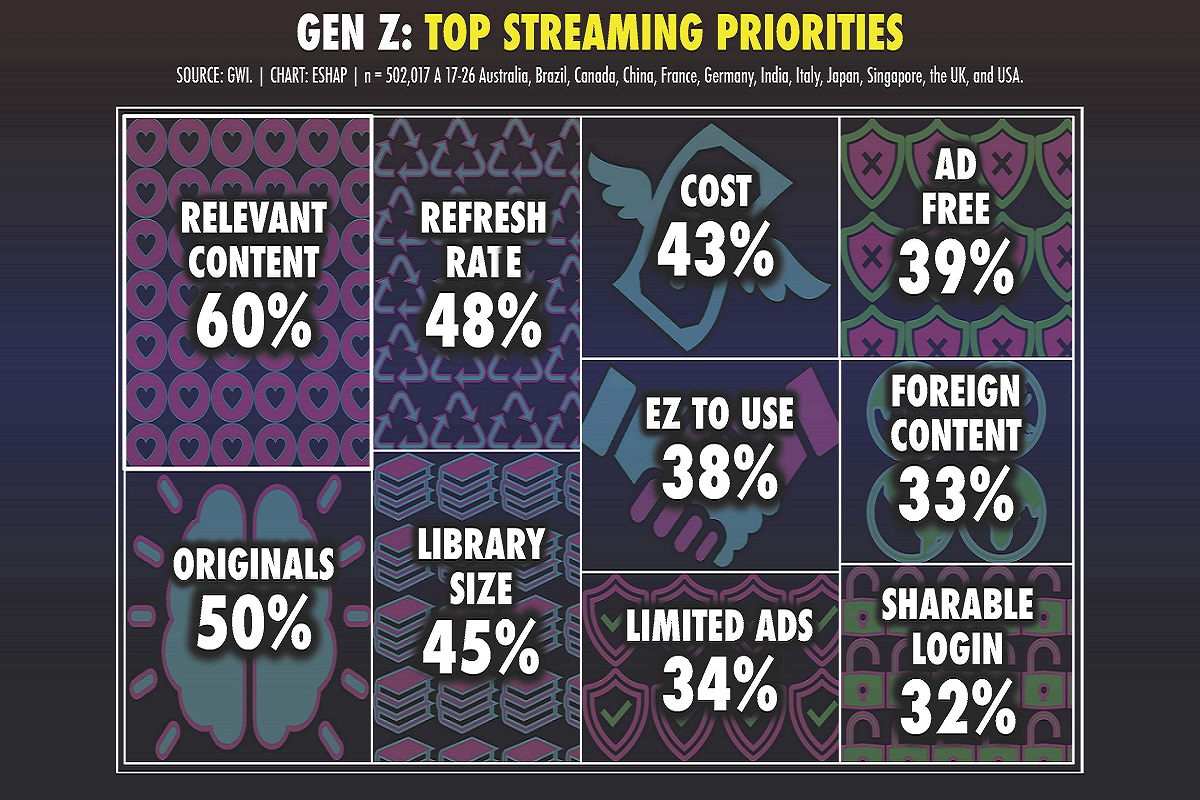
TL;DR
- Media cartographer Evan Shapiro delivered the closing keynote address at Streaming Media East, providing a close look at the latest consumer data in the global streaming marketplace.
- It’s critical for stakeholders to understand shifts in demographics in the world’s population, Shapiro says, in order to identify untapped markets.
- Younger generations are more likely to pay for services they want, he says, because they’ve been trained to do that since birth.
- Shapiro predicts that the current advertising recession in the US will end in July, but that doesn’t necessarily mean the outlook is rosy.
Evan Shapiro loves to talk. And that’s a good thing, because his insights into the Media & Entertainment industry are invaluable, plotting the effects of disruption as the streaming universe changes its gravitational pull and reforms itself around new business models. The media cartographer and ESHAP CEO — known for his detailed maps and accompanying analysis charting the media universe — provided a close look at the latest consumer data at the Streaming Media East conference. You can watch the full session, “The Mind of the Modern Media Consumer,” in the video below.
(Shapiro has been talking up a storm lately, making the rounds on multiple continents with his latest presentation, “Yes, And: How To Survive The Media Apocalypse.”)
Shapiro spoke about shifts in consumer demographics, how streaming is changing the television landscape, and survival tactics for an increasingly volatile ecosystem. He also predicted that the current advertising recession will end in July, with new data to back up that claim, and identified the biggest areas for growth.

“Constant disruption is now the operating system of our ecosystem,” Shapiro said in his opening remarks, noting that his job is to help stakeholders survive what he calls “the current media apocalypse.”
In a global marketplace, Shapiro said, it’s important to understand the demographic changes in the world’s population. “One of the things that you have to know is that the population on the planet Earth is completely different now from what it is when most of us were growing up,” he said, pointing out that 63% of the world’s population is now under the age of 40. “So If you’re over the age of 40, you’re in a minority for the first time in your life.”
But what’s even more critical to understand, says Shapiro, is how the demographics break down across regions: 33% of the world’s population is under 20, but that number changes drastically by region. In North America it’s 25%, and in Europe it’s 21%, but in Asia and Latin America that figure jumps to 32%, and in Africa it’s a whopping 51%.
“Half of the fastest growing economies on the face of the earth are in Africa,” he says. “So think about the world as you think about your business, look for opportunity outside of where you’re operating today.”
READ MORE: Evan Shapiro: M&E Is Being Reassembled in Real Time (NAB Amplify)
Shapiro also tackled misconceptions that younger consumers don’t want to pay for services. That’s “absolutely untrue,” he said, “The younger consumer is more apt to pay for services. They want to pay for media. We’ve raised three generations, the youngest generations, the largest generations, the most diverse generations on the planet, to pay for their media.”
He also pointed out that, according to surveys, the most important things to young subscribers are “relevant content, original content, refreshed content, and library size,” all of which are ranked as more important than cost.

Not thinking globally is a sure business-killer, Shapiro insists, using Roku as an example. “Roku is the number-one platform for streaming television on the planet Earth,” he said. “They’re not in the top five anywhere outside of the United States. So if you think about how to lose your business, focus only on America. And if you wanted to look at a good case study, look at Roku’s stock price over the last 24 months. Not a good story. Right? They moved far too late to go global, and it’s killing them right now.”
Companies like Samsung and Google, Shapiro said, are the new gatekeepers, and “in many cases, also your direct competitors.”
Samsung has already moved into publishing content, he said, noting that that streamers have to be included in the company’s home screen offerings to be considered a global publishing brand.
“Google is the direct competitor and an aggregator of yours. So this idea that we have these ‘frenemies’ I am now rebranding them — or trying to — into collaborators. You’re competing with them. And you also have to bear hug them, you don’t have a choice,” he continued.
“The idea that you’re going to be able to operate around these collaborators, specifically, Google is adorably naive, it’s just not possible. So you have to think about a way to both compete with them, and collaborate with them simultaneously.”
READ MORE: Evan Shapiro: Streaming Habits Have Shifted (Again)… Here’s How and Why (NAB Amplify)
But what about that ad recession, you ask? Shapiro had plenty to say about that, along with some cold, hard data to back everything up. The upshot is that churn is the killer of advertising. “Serial churning is the new channel changing,” he said, and “when somebody cancels a subscription, not only do [streamers] lose that subscriber revenue, they also lose those ad impressions.”
In Q4 of last year, Shapiro noted, SVODs signed up 41.3 million new subscribers and lost another 33.8 million subscribers, an 82% loss. “That’s a shitty business, and, by the way, not great for advertisers,” he commented.
The US advertising market has experienced nine months of decline, Shapiro observed, but “bold prediction for you — the ad recession will end in July.”
Math, he says, has provided the answers. “The reason why we’re in an ad recession is primarily due to the comparison to the year prior,” he says, looking at ad revenue from the first quarter of 2022.
“It’s hard to keep that pace up,” he adds. “Now in July, the comparison is going to be a lot easier than it was a year ago. The ad recession is going to end magically in the middle of this summer, because math, and you’re going to hear about how advertising is back this fall.”
The outlook isn’t entirely rosy, however, Shapiro warns: “What’s going to happen though, is not all the ads are going to be shared equally amongst all the players. Because gravity sucks. Ads are going to go where the ads are most effective; ads are going to go where the ads are already working.”
Head over to Shapiro’s blog on Substack, Media War & Peace, to download the full deck for “Yes, And: How To Survive The Media Apocalypse.”

